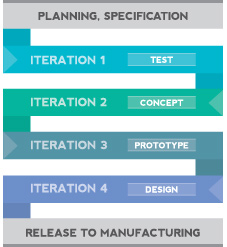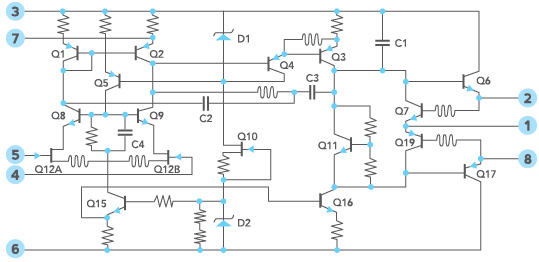
Product Development Stages

When designing new products, we adhere to a strict classification of seven main development stages developed by Seal. We understand that by skipping any stage of project development, we increase the risks and shift them to the final stage of product full-scale production when modifications are more difficult and more costly.
Some stages can have several iterations, and this is normal in the process of creating technically complex and competitive products. Iterative approach is also often applied when creating software-hardware platforms, designed for building product line-ups on their basis.
The product development process can be split into the following stages:
• Product concept creation
• Proof-of-Concept
• Electronic device development
• Assembly and verification of pilot batch
• Certification tests
• Preparation for production and pilot batch launch
• Full-scale production
Product concept creation
This is the stage of development when ideas begin to take the shape of a commercially successful product. Technical specialists and industry experts prepare a detailed requirements specification and product concept design, with a full description of functional features and benefits.
The result of this stage of development is a completed documentation package that defines the product concept.
Proof-of-concept
At this stage, we create a draft project, prepare requirements, write specifications, and analyze possible product uses.
Next, we specify prices with components manufacturers, and sign NDAs with the corresponding manufacturers of the component base for receiving additional technical information. After this, we select base components and make preliminary calculations of product by taking into account the costs of manufacturing in different batches.
Specialists verify device implementation and very often by the end of this stage, they assemble and test a device prototype. To develop and assemble the prototype, we buy an Evaluation Kit for the selected target platform. Engineers evaluate the selected hardware and software technical solutions; examine potentially weak points from the point of view of technical implementation, platform performance and other important characteristics. As a result, they can come to a conclusion about the correctness of the product's target platform choice.
The result of this stage is the conclusion about the correctness of the selected platform and justification of technical decisions. A 'Desk-type' device prototype with limited functionality may also be created during this stage.
Electronic device development
The purpose of this stage is to create a design and project documentation package for the device. At this stage, we confirm components and design printed circuit board (PCB).
Engineers design Human-Machine Interfaces (HMI) and define the control and information display units required for user interface. They also build the function tree and control concepts.
Together with schematic development, we create a device case design. Based on this sketch and the HMI, we create a solid model and device construction and perform PCB layout in the necessary form-factor.
The software architecture, which was defined at the previous stage, is implemented and the software is adapted and elaborated. Specialists create all types of tests for verifying the correctness of software operation. They also compose test programs that will allow checking of both software and hardware operation.
The result of this stage is a package of design documentation for the device and the completion of final preparations for manufacturing the pilot batch.

Pilot batch
The purpose of this stage is to manufacture a pilot batch for verifying the device operability and eliminating any possible errors made in the design stage. The pilot batch samples can then be used to market the product to potential customers and investors or prepared for device certification tests.
At this stage our specialists purchase components, put PCBs into production and assemble them, check the device case for ease of assembly, and order device cases which are close to the final variant. After assembling the PCBs, they perform a "bring-up" (first launch/start). Then they port the operating system and boot-loader, elaborate drivers, system and high-level software. All device components are assembled together and thorough integration testing is performed.
After the results of testing and/or test operation, functional requirements for the product can be elaborated and design documentation can be changed as needed. The majority of functionalities implemented on the program level do not require any hardware changes – that is why they can be handled during other product development stages. Sometimes clients may decide to repeat one or more development iterations, which can lead to changes in schematics, construction, PCBs, etc. The risks of such a scenario are much higher if you skip Stage 1 or 2 of the development process: 'Product Concept Creation' and 'Proof-of-Concept'.
The result of this stage is the creation of a functional pilot batch for integration testing. After the results of the testing, changes in the design documentation can be made as necessary.
Certification tests
Our experience shows that if you do not take into consideration the necessity of making preliminary certification tests, then you are at a higher risk of experiencing material losses later. At this stage, we need to define the class of the device, the necessity of making preliminary certification tests, and prepare the test schedule. After the results of preliminary certification tests, we must protocol the results of measurements made and, if necessary, make changes in design documentation.
Preparation for production and pilot batch launch
The main purpose of the pilot batch launch is to prepare the product for full-scale production and check the manufacturing of the device in real production. At this stage we can detect product defects, which may not have been detected on the small number of samples, and make minor changes in schematics, case design and PCB.
The specialists then make the final optimization of BOM (Bill of Materials), write final documentation and, with the help of technologists, they create assembly charts targeted for a specific production. They also plan logistics in detail, exploring the risks and bottlenecks of full-scale production.
The team also develops and checks test coverage for JTAG analyzer, introducing this technology into production. Other tasks in this stage include development of tools for POST testing and post-production tests in case it is necessary to increase test coverage.
The result of this stage is a manufactured pilot batch and documentation package for launching the product into full-scale production.
Full-scale production
The purpose of this stage is the industrial production of the device, ready to be sold to the end user.
At this stage, developers can support full-scale production by:
- • controlling the technological process;
- • controlling product quality;
- • promptly reacting to replacements of electronic components due to various reasons (such as components that are not available or out of production);
-
• defining the possible reasons of the emergence of defects in production (low-quality components, violation of technological process, etc); and
-
• improving tests and increasing test coverage for bottlenecks detected during production.
